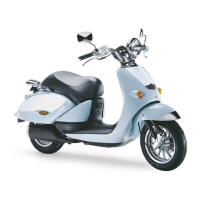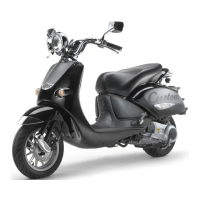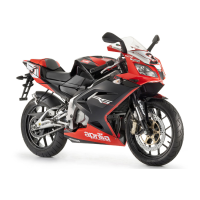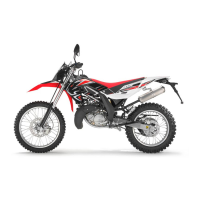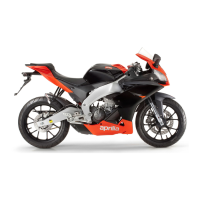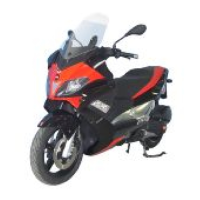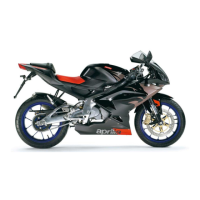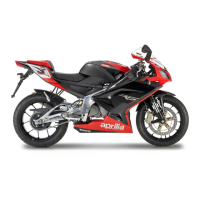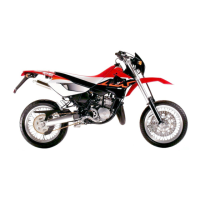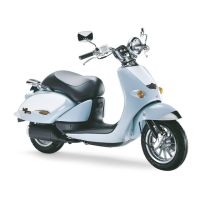
Do you have a question about the APRILIA HABANA 125 - PART2 and is the answer not in the manual?
| Brand | APRILIA |
|---|---|
| Model | HABANA 125 - PART2 |
| Category | Motorcycle |
| Language | English |
Possession of driving license, minimum age, insurance, registration, and other legal requirements.
Start driving in low-traffic or private areas to get to know the vehicle's handling.
Medicines, alcohol, and drugs notably increase accident risk. Drive sober and alert.
Ensure good psychophysical condition and pay attention to weariness and drowsiness.
Most accidents stem from lack of experience; never lend to beginners.
Rigorously observe all road signs and national/local road regulations.
Avoid abrupt movements that can be dangerous to yourself and others.
Avoid obstacles that could damage the vehicle or cause loss of control.
Avoid riding in the slipstream of preceding vehicles to increase speed.
Keep both hands on handlebars and feet on footrests for correct posture.
Pay attention and avoid distractions from people, things, and movements.
Use specified fuels and lubricants; check fluid levels regularly.
Check for damage to controls, brakes, and vital parts after an accident.
Modifications may require new homologation, registration, and appropriate license.
Modifications can void insurance as they often prohibit technical changes.
Tampering is punished by law with sanctions, including vehicle confiscation.
Do not keep pointed objects like keys or pens in pockets, as they are dangerous in a fall.
Owner is responsible for accessory choice, installation, and use.
Avoid electrical overloads by not installing or modifying electrical devices.
Avoid hanging bulky items on handlebars/forks as it impairs maneuverability.
Secure bags tightly; avoid bags that protrude or cover lights/indicators.
Do not carry animals or children on the glove compartment or luggage rack.
Overloading compromises vehicle stability and maneuverability.
Diagram identifying numbered components specific to the H50 model.
Diagram identifying numbered components specific to the HC50 model.
List of numbered components for both H50 and HC50 models.
Diagram identifying numbered components specific to the H125 model.
Diagram identifying numbered components specific to the HC125 model.
List of numbered components for both H125 and HC125 models.
Diagram of instrument clusters for H50 and H125 models.
Diagram of instrument clusters for HC50 and HC125 models.
Diagrams illustrating the location of handlebar controls.
List identifying numbered controls and indicators on the vehicle.
Table detailing the function and meaning of various warning lights.
Description of horn, dimmer, and indicator switches on the left handlebar.
Details on how to activate the horn using the push button.
Explanation of the dimmer switch positions for high/low beam.
Description of light and engine stop switches on the right handlebar.
Explanation of the light switch functions for parking, low, and high beams.
Details on the safety function of the engine stop switch.
Instructions for using the electric start push button.
Description of horn, dimmer, and indicator switches on the left handlebar.
Details on how to activate the horn using the push button.
Explanation of the dimmer switch positions for high/low beam.
Description of light and engine stop switches on the right handlebar.
Explanation of the light switch functions for parking, low, and high beams.
Details on the safety function of the engine stop switch.
Instructions for using the electric start push button.
Description of the ignition switch's role in operating electrical parts.
Procedure for locking the steering to prevent unauthorized movement.
Table detailing steering lock positions, functions, and key removal.
Procedure to unlock, lift, and lock the vehicle's saddle.
Description of the under-seat storage compartment for helmets and items.
Description of the anti-theft hook and its recommended use with security cables.
Details on the contents of the tool kit and how to access it.
Information on the bag hook's weight limit and usage restrictions.
Instructions for opening and locking the glove compartment.
Essential safety measures for handling flammable fuel and avoiding hazards.
Specification of recommended petrol grades for different vehicle models.
Step-by-step refueling process and critical warnings for safe operation.
Warnings regarding skin contact with oil and recommendations for using gloves.
Procedure for topping up the 2-stroke oil tank and associated warnings.
Procedure for checking engine oil level and topping up if necessary.
Recommendations for checking and changing transmission oil at specified intervals.
Importance of brake system working condition and regular brake fluid changes.
Steps to check the brake fluid level in the reservoir.
Instructions for visually checking the wear on the front brake pads.
Procedure for adjusting the rear drum brake clearance.
Signs indicating that the brake shoes are worn out.
Importance of checking tyre inflation pressure and its impact on handling.
Checking tyre surface, wear, and age for optimal performance and safety.
Guidelines for tyre replacement and the necessity of wheel balancing.
Using only tyres in the size and type suggested by the manufacturer.
Ensuring valve sealing caps are always in place to prevent sudden deflation.
Advising qualified technicians for tyre repair, maintenance, and balancing.
Specifies the minimum legal tread depth for front and rear tyres.
Description of vehicles with automatic light-on feature as soon as the engine starts.
Caution about the catalytic silencer becoming extremely hot during use.
Explanation of how the catalytic converter oxidizes exhaust gases.
Warning against tampering with the noise control system as it's prohibited by law.
Carrying out preliminary checks ensures vehicle functions correctly and safely.
Table listing components, their checks, and corresponding page references.
Warnings regarding exhaust gas hazards and avoiding starting in enclosed spaces.
Step-by-step instructions for starting the engine using the electric starter.
Instructions for starting the engine using the kick starter.
Procedure to clear a flooded engine by using throttle and starter.
Tips for starting the engine in cold temperatures or low ambient conditions.
Procedure for starting the vehicle after a prolonged period of non-use.
Review 'safe drive' chapter and check fuel level before departure.
Ensure passenger footrests are folded; instruct passenger for safe riding.
Adjust rear-view mirrors correctly and get acquainted with their use.
Warm up the engine by driving at low speed for the first miles.
Avoid opening and closing the throttle repeatedly to prevent loss of control.
Use both brakes for uniform deceleration; avoid sudden braking.
Drive slowly on wet roads, avoiding sudden maneuvers that could cause skidding.
Use direction indicators in time for lane changes; switch off promptly.
Be careful when overtaking or being overtaken; note visibility issues in rain.
The running-in period is crucial for ensuring the engine's correct functioning.
Restrictions on throttle opening and braking during the initial running-in period.
How to stop the vehicle safely by releasing throttle and applying brakes gradually.
Park on firm, flat ground; avoid leaning against walls or laying on ground.
Turn off ignition, avoid battery drain, never leave key in ignition switch.
Steps for positioning the vehicle on the centre stand.
How to use the centre stand to park the vehicle securely.
How to use the side stand and ensure vehicle stability.
Tips to prevent theft and record personal data for owner identification.
Warnings regarding fire risk, hot parts, and avoiding ingestion of parts.
Advice on reassembly order and the recommendation to use latex gloves.
Consult official dealers for technical advice or complex maintenance operations.
Explanation of service codes (C, P, S, R) and notes on frequent maintenance.
Table detailing components and their recommended service intervals for H50/HC50.
Explanation of service codes (C, P, S, R) and notes on frequent maintenance.
Table detailing components and their recommended service intervals for H125/HC125.
Information on finding the frame number and its significance for parts purchase.
Information on finding the engine number and its importance.
Procedure for checking the engine oil level using the sight glass.
Procedure for adding engine oil, including warnings and cautions.
Steps to remove the air cleaner element for cleaning or replacement.
Instructions for cleaning the air filter element using appropriate solvents.
Steps to remove the air cleaner element for cleaning or replacement.
Instructions for cleaning the air filter element using appropriate solvents.
Procedure for checking the wear of the front brake pads.
Risks associated with excessive brake pad wear, including disc damage.
